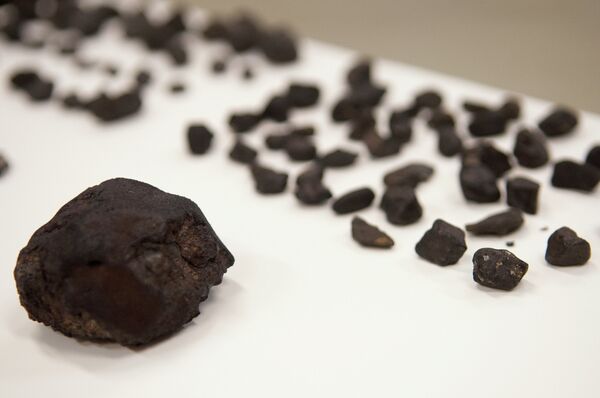WASHINGTON, April 16 (By Maria Young for RIA Novosti) – Two months after a meteorite exploded over the Chelyabinsk region of Russia and slammed into the Ural mountain range, a collection of meteorite pieces gathered in the aftermath is on display at the Field Museum of Natural History in Chicago.
“This particular event was like one in a century and the fact that there were so many dashboard cameras and so many witnesses, and also because of the close flyby of an asteroid on the same day, space has really captured the public’s imagination,” said Jim Holstein, collections manager of meteorites and mineralogy at the Field Museum, in an interview with RIA Novosti.
“People are fascinated with meteorites this year. It’s the year of the space rock,” he added.
Tracking down several hundred pieces of the Russia space rock started with a late night phone call between meteorite collector Terry Boudreaux and Michael Farmer, a meteorite hunter that Boudreaux calls “the Indiana Jones of meteorites.”
“He called me 30 minutes after this hit the press and said, ‘Did you hear what happened in Russia?’ The estimates were 10,000 to 11,000 tons (9,072 to 9,979 metric tons) coming into the atmosphere, so we knew it was huge. And we were talking about it and Michael said, ‘I’ve got to get over there,’” Boudreaux told RIA Novosti.
The two men partnered up for the project, but it took several weeks to get a visa arranged for Farmer to head to Russia. By then, meteorite pieces were popping up for sale on eBay.
“NASA saw a piece blow off on video and they estimated that little tiny dot weighed 10 tons (9 metric tons) and it’s probably in the Ural mountains where it’s heavily forested. At the same time, we knew local villagers were finding pieces, so we knew there was a lot,” Boudreaux said.
Farmer arrived in Chelyabinsk on the one-month anniversary of the meteorite.

“It’s the biggest fall we’ve seen in history, a quarter million pieces have been picked up, and that was before the snow came, which made it pretty difficult to find any more pieces for a while,” said Farmer in an interview with RIA Novosti from Europe, where he was meeting with Russian citizens hoping to sell more chunks of the meteorite.
“Right after it hit, thousands of people went out there from the local towns and everybody picked up hundreds of rocks. It’s the new Russia, everybody’s trying to make a buck,” he said. He paid for rocks that were collected, and brought several kilograms back to the United States.
By then, the Russian scientific community had been able to do an initial analysis of the space rock, which can determine everything from the chemical composition of the rock to where it came from. They know it originated in the asteroid belt between Jupiter and Mars.
“That’s the currency of the scientific world, it’s the papers and the data and whoever gets it out first gets the credit for doing the initial scientific work. This is truly the most important meteorite event in history,” said Farmer.
“You have basically a nuclear bomb blast above a populated city. There will be thousands of papers written on this, on everything from the explosive force to the shock waves,” he added.
For Farmer and Boudreaux, the key is getting the space rocks into scientific hands all over the world as quickly as possible, where it can be studied.
“To fully understand these meteorites you have to have a large community with different areas of expertise. I can’t speak to the political aspects but scientifically we have a very strong cooperation within the Russian scientific community,” said Holstein.
When Boudreaux donated 234 pieces of the meteorite – roughly two pounds (.9 kg) – to the Field Museum, it took excited curators and exhibition experts working furiously to put 50 pieces on display less than 24 hours later.
The remaining pieces are being catalogued at the museum’s Robert A. Pritkzer Center for Meteoritics and Polar Studies, which will make the pieces available to scientists and universities for study and analysis.


